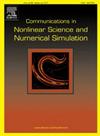Inverse source problem for the time-space fractional diffusion equation involving the fractional Sturm–Liouville operator
IF 3.4
2区 数学
Q1 MATHEMATICS, APPLIED
Communications in Nonlinear Science and Numerical Simulation
Pub Date : 2025-03-19
DOI:10.1016/j.cnsns.2025.108772
引用次数: 0
Abstract
In this work, we consider an inverse source problem for the time-space fractional diffusion equation with homogeneous Dirichlet boundary conditions, in which the spatial operator under consideration is the fractional Sturm–Liouville operator. We demonstrate that this inverse source problem is ill-posed in the sense of Hadamard and exhibit the uniqueness and conditional stability of its solution. To recover a stable solution, we employ an iterative generalized quasi-boundary value regularization method. We derive error estimates between the exact and regularized solutions based on both a-priori and a-posteriori choice rules for the regularization parameters. Notably, our method reduces to the generalized quasi-boundary value regularization method after one iteration and exhibits a better error convergence rate. Finally, we present three numerical examples to validate the effectiveness of the used regularization method.
含分数Sturm-Liouville算子的时空分数扩散方程的逆源问题
本文考虑了具有齐次Dirichlet边界条件的时空分数阶扩散方程的逆源问题,其中所考虑的空间算子为分数阶Sturm-Liouville算子。我们证明了该逆源问题在Hadamard意义上是病态的,并证明了其解的唯一性和条件稳定性。为了恢复稳定解,我们采用了一种迭代广义拟边值正则化方法。我们基于正则化参数的先验和后验选择规则推导出精确解和正则解之间的误差估计。值得注意的是,我们的方法在一次迭代后简化为广义拟边值正则化方法,并且具有更好的误差收敛速度。最后给出了三个数值算例,验证了正则化方法的有效性。
本文章由计算机程序翻译,如有差异,请以英文原文为准。
求助全文
约1分钟内获得全文
求助全文
来源期刊

Communications in Nonlinear Science and Numerical Simulation
MATHEMATICS, APPLIED-MATHEMATICS, INTERDISCIPLINARY APPLICATIONS
CiteScore
6.80
自引率
7.70%
发文量
378
审稿时长
78 days
期刊介绍:
The journal publishes original research findings on experimental observation, mathematical modeling, theoretical analysis and numerical simulation, for more accurate description, better prediction or novel application, of nonlinear phenomena in science and engineering. It offers a venue for researchers to make rapid exchange of ideas and techniques in nonlinear science and complexity.
The submission of manuscripts with cross-disciplinary approaches in nonlinear science and complexity is particularly encouraged.
Topics of interest:
Nonlinear differential or delay equations, Lie group analysis and asymptotic methods, Discontinuous systems, Fractals, Fractional calculus and dynamics, Nonlinear effects in quantum mechanics, Nonlinear stochastic processes, Experimental nonlinear science, Time-series and signal analysis, Computational methods and simulations in nonlinear science and engineering, Control of dynamical systems, Synchronization, Lyapunov analysis, High-dimensional chaos and turbulence, Chaos in Hamiltonian systems, Integrable systems and solitons, Collective behavior in many-body systems, Biological physics and networks, Nonlinear mechanical systems, Complex systems and complexity.
No length limitation for contributions is set, but only concisely written manuscripts are published. Brief papers are published on the basis of Rapid Communications. Discussions of previously published papers are welcome.
 求助内容:
求助内容: 应助结果提醒方式:
应助结果提醒方式:


